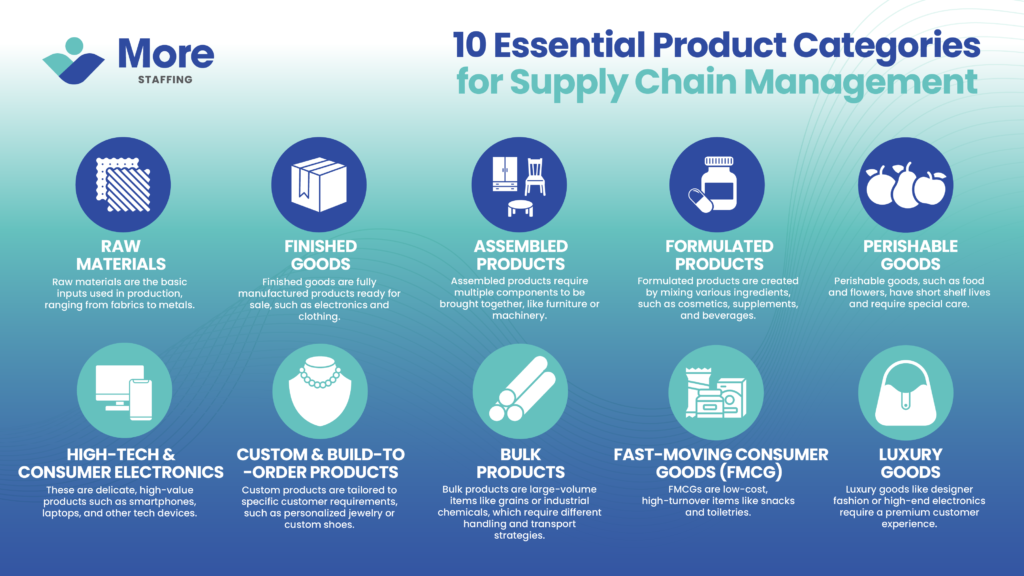Efficient supply chain management is critical for e-commerce businesses, and product categorization is crucial in streamlining operations. By organizing products into categories, you can better align logistics, storage, and distribution strategies, significantly reducing inefficiencies and optimizing costs.
This blog will introduce you to ten key product categories every e-commerce business should know. Then, explore hybrid products that span multiple categories, offering insights into managing their unique supply chain needs.
The Importance of Product Categorization in E-commerce

Product categorization is a strategic tool that improves logistics, reduces costs, and enhances operational efficiency. Each product category has unique needs, and recognizing these distinctions allows you to:
- Improve logistics by aligning products with appropriate shipping and storage solutions.
- Reduce costs by optimizing inventory management specific to each product type.
- Increase efficiency with faster fulfillment and more reliable distribution.
By understanding your products’ supply chain needs, you can implement tailored strategies that help scale your business efficiently. Learn more in our on-demand webinar, which provides deeper insights into product categorization’s role in supply chain optimization.
10 Essential Product Categories for Supply Chain Management

1. Raw Materials
Raw materials are the basic inputs used in production, ranging from fabrics to metals.
- Key Points: Bulk handling, procurement efficiency, and pre-production storage.
- Supply Chain Strategy: Optimize sourcing and minimize replenishment delays to keep production flowing smoothly. Efficient handling of bulk materials ensures continuous supply for manufacturing.
2. Finished Goods
Finished goods are fully manufactured products ready for sale, such as electronics and clothing.
- Key Points: Ready-to-sell, storage, and timely distribution.
- Supply Chain Strategy: Implement warehouse management systems to ensure products are stored correctly and delivered quickly. Balance inventory levels to avoid both overstocking and stockouts.
3. Assembled Products
Assembled products require multiple components to be brought together, like furniture or machinery.
- Key Points: Part management, pre-assembly logistics.
- Supply Chain Strategy: Manage logistics for parts and materials efficiently. Ensure timely assembly and consider offering installation services to add value post-delivery.
4. Formulated Products
Formulated products are created by mixing various ingredients, such as cosmetics, supplements, and beverages.
- Key Points: Ingredient blending, regulatory compliance, and handling.
- Supply Chain Strategy: Establish stringent quality control for shelf life and labeling compliance. Stay updated on regulatory changes to avoid disruptions in distribution.
5. Perishable Goods
Perishable goods, such as food and flowers, have short shelf lives and require special care.
- Key Points: Temperature control, time-sensitive logistics.
- Supply Chain Strategy: Invest in cold storage and rapid logistics solutions. Use predictive analytics to forecast demand accurately, minimizing waste and spoilage.
6. High-Tech & Consumer Electronics
These are delicate, high-value products such as smartphones, laptops, and other tech devices.
- Key Points: Sensitive components, high-value handling.
- Supply Chain Strategy: Employ secure transportation and climate-controlled storage to prevent damage. Ensure anti-theft measures are in place to protect high-value items.
7. Custom & Build-to-Order Products
Custom products are tailored to specific customer requirements, such as personalized jewelry or custom shoes.
- Key Points: Flexible timelines, custom workflows.
- Supply Chain Strategy: Develop agile production systems to handle variability and ensure raw materials are readily available for customization. Track orders meticulously to keep customers informed.
8. Bulk Products
Bulk products are large-volume items like grains or industrial chemicals, which require different handling and transport strategies.
- Key Points: Large-scale storage, efficient transportation.
- Supply Chain Strategy: Utilize freight consolidation and invest in large-capacity storage facilities. Specialized equipment for loading and unloading bulk items is essential for efficiency.
9. Fast-Moving Consumer Goods (FMCG)
FMCGs are low-cost, high-turnover items like snacks and toiletries.
- Key Points: Rapid replenishment, agile distribution.
- Supply Chain Strategy: Implement fast inventory turnover systems and accurate demand forecasting to ensure quick restocking. Streamline logistics to get products to market efficiently.
10. Luxury Goods
Luxury goods like designer fashion or high-end electronics require a premium customer experience.
- Key Points: Premium packaging, exclusive distribution, security.
- Supply Chain Strategy: Invest in high-end packaging and secure, specialized logistics to maintain product integrity. Focus on creating a seamless delivery experience that reflects the product’s luxury status.

Hybrid Products: Managing Products That Span Multiple Categories
Hybrid products present a unique challenge because they combine features from two or more product categories, requiring a blend of supply chain strategies to manage their logistics effectively. These products often have diverse handling, inventory, and regulatory needs, making them more complex to manage.
What Are Hybrid Products?

Hybrid products span different categories, meaning they have overlapping supply chain requirements. Some common examples include:
- Smart Apparel: Combines assembled products (garments) and high-tech consumer electronics (embedded technology).
- Supply Chain Needs: Requires precise assembly, climate-controlled storage for tech components, and secure transportation to protect high-value electronics.
- Vitamin-Infused Beverages: A combination of formulated products (ingredient blending) and FMCG (high demand and quick turnover).
- Supply Chain Needs: Needs compliance with food safety regulations, fast replenishment, and efficient production workflows to meet high consumer demand.
- Customizable Sneakers: Falls under both finished goods and custom & build-to-order categories.
- Supply Chain Needs: This requires managing base inventory while offering flexibility for customization. Efficient workflows for both standard and bespoke orders are essential.
- Gourmet Cheese: A hybrid of perishable goods and luxury items.
- Supply Chain Needs: Cold-chain logistics are required for preservation, premium packaging and exclusive distribution.
Key Challenges in Managing Hybrid Products
- Diverse Handling Requirements: Hybrid products often need different storage and transportation solutions, such as climate-controlled environments for tech products or cold storage for perishables.
- Complex Inventory Management: Balancing base inventory for mass production and customized elements can complicate inventory control. For example, a product may need both a standard stock level for finished goods and dynamic inventory for customized orders.
- Regulatory Compliance: Hybrid products often need to comply with multiple sets of regulations—such as tech safety standards and food safety laws—making it more challenging to streamline production and distribution.
Strategies for Success
- Flexible Inventory Systems: Use dynamic inventory management systems that can handle fluctuating demand for hybrid products, especially those requiring customization or multiple components.
- Cross-Category Logistics Solutions: Work with logistics partners who can manage the unique transportation needs of hybrid products. For example, cold storage and secure handling for luxury or tech components may both be necessary.
- Collaborative Supply Chain Management: Cross-functional collaboration between departments (e.g., product development, logistics, and regulatory teams) is essential to manage the multiple requirements of hybrid products. Frequent coordination ensures smooth handling across the supply chain.
- Specialized Packaging and Delivery: Hybrid products often need innovative packaging solutions to meet their diverse requirements. For example, premium packaging may be required to protect delicate, high-value tech components while preserving perishable elements.
Hybrid products add complexity but also create opportunities for differentiation in the market. By implementing flexible, tailored strategies, you can manage hybrid products efficiently while ensuring your supply chain remains responsive to their unique needs.
Download Our Smart Product Categorization Guide Now!
Implementing Product Categorization in Your Supply Chain

Optimizing your supply chain begins with effective product categorization. Here’s a step-by-step guide:
Step 1: Evaluate and Group Your Product Line
Review your entire product range and categorize products based on handling, logistics, and customer needs. For example, perishable goods may form one category, while luxury items form another.
Step 2: Assign Tailored Supply Chain Strategies
For each product category, develop specific supply chain strategies:
- Perishables: Focus on cold storage and rapid distribution.
- Luxury Goods: Implement secure packaging and white-glove delivery services.
- FMCG: Prioritize fast restocking and efficient inventory turnover.
Step 3: Optimize Inventory Management
Use demand forecasting tools to optimize inventory management based on product type. For example, high-demand items may require faster replenishment, while seasonal products need tailored stock management.
Step 4: Adjust Logistics for Specific Needs
Tailor your logistics strategies to the needs of each product category. Adjust temperature control, security measures, and specialized delivery options accordingly to meet each category’s specific requirements.
Conclusion: Unlock Efficiency with Smart Product Categorization
Product categorization is a powerful tool for streamlining your supply chain, improving efficiency, and reducing costs. By organizing products into well-defined categories and applying tailored strategies, you’ll ensure your e-commerce business is prepared to meet customer demands, whether you’re managing raw materials, luxury goods, or hybrid products.
Ready to optimize your supply chain? Contact us today to discover how our staffing solutions can help you find the right talent to streamline your product categorization and enhance efficiency. Together, we can drive your business forward!




